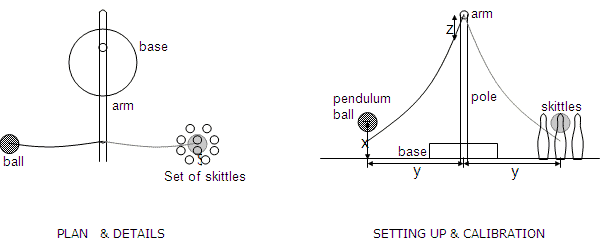Pendulum Bowling
Pendulum Bowling is an independent game of skittles whereby the suspended ball and gravity can do all the work.
Pendulum Bowling is a game that can be accessed by a wide range of individuals with differing special needs and for mainstream participants as well. The ball is held at the length of the attached line from the stand and released slightly pushed. With the set of nine skittles there are the numerous attempts possible to knock them down.
Particular attention needs to be made with the alignment of the players that might have the use of a wheelchair, crutches or walking frame. The arm height or starting line, or both may need to be adjusted for success to be ensured with the pendulum swing and strike of the skittles. Participants should be encouraged to release or drop the ball and NOT throw it, as this will place stress on the pendulum arm.
Success could be just as much in the 'process' as with any 'game' version adopted and the use of cross curricular links could give the activity added educational value.
This game will help users accomplish:
- Better manipulative control of grasp and release.
- Development of better perceptual motor abilities because it is in a semi controlled context (i.e. not too dynamic)
- Enjoyment and motivation will be a positive outcome because success is guaranteed with sensory feedback and stimulation of the skittles visually falling down and the accompanying sound.
The game
1. Setting up and calibration

2. The basic game (Technical access)
'Knock them down': The traditional game requires the pendulum to be released with an aim at the set of skittles or a particular skittle. The swinging pendulum can be left swinging to knock over multiple skittles until it is stationary. All activities or games could be carried out in different organisational contexts i.e. individual, pair, group or team.
How many skittles can be knocked down in 5 releases?
3. Versions of the game (Technical access)
- 'Swing and miss': The opposite aim of the regular game above. The player has five attempts to release / swing the ball around or up and down near the skittles without knocking any over. As the ball returns the string may be caught to finish the turn. The number left up is the score.
- 'Number skittles': Skittles are numbered or colour coded and the player is required to knock them down in a specific order i.e. 6, 1, 4, 3, 2. As long as the designated skittle is knocked down any others can then be stood up again. The toppled designated skittle is removed and the game progresses. How many turns does it take to topple them all in the correct order?
- 'Release and catch'; Only the centre skittle is set up as an obstacle: The player releases or pushes the ball and endeavours to make it come back in an arch around the single skittle so the ball can be caught. How many attempts does it take to achieve 5 catches altogether?
- 'Domino skittles': The aim is to knock down skittles in multiple numbers i.e. one can knock any number of others down. If a single skittle remains then another has to be placed back so there are at least 2 to knock down to finish the game. How many attempts does it take?
4. Outcomes of the games (Technical impact)
The results from being engaged in the process will be:
- Satisfaction of being engaged in a challenging target type of game – fun, enjoyment and self esteem.
- Increased neuro-muscular control will also be a consequence – skill and technique.
- A possible higher level of achievement will be cognitive planning – decision making, tactics and strategies.
- Depending upon the setting it could yield – psycho/social outcomes of peer sharing/cooperation.
5. Scoring
| Names | Attempts | |||||||
|---|---|---|---|---|---|---|---|---|
| 1 | 2 | 3 | 4 | 5 | Sub-totals | Total | ||
|
e.g. John | S | 2 | 1 | 0 | 1 | 0 | 4 | 7 |
| R | 1 | 0 | 1 | 0 | 1 | 3 | ||
|
e.g. Mary | S | |||||||
|
e.g. Sue | S | |||||||
S= Skittles directly knocked down per swing
R= Skittles knocked down by rebound swings per swing
6. Teacher guidelines
Peer Assessment: Working in pairs, observe one another taking turns and tell your friend what was the best part of each swing.
Strategies of how to Play: Rank what you think are the most important parts of the game strategy?
- Using a hard fast swing
- Sometimes using the outward swing
- A slow straight forward swing to the centre of the pins
- Aiming at the front centre pin
- Being able to do the around the back swing at the pins
Swing Technique: What are the three best ways to improve your score:
- Where you stand or place the frame/wheelchair
- How you hold the ball
- The aim and release
- The way you think about it
- By changing the starting position
- How much force you put on the swing
Affective Domain: Name three of the best parts of the game for you and three of the most challenging parts of the game?